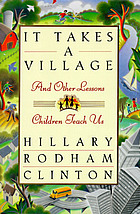
For most of the late twentieth century, the autobiography has offered political figures a personalized genre for engagement and persuasion. Increasingly, the political autobiography has gained popularity as a means for articulating life experience, a political vision or point of view that coincides with a political event, a campaign, a reelection, or a defeat. Taken in context of more personalized “life writings,” Clinton’s autobiographical works offer readers a unique self-portrait, and as a result, make them essential reading. While these autobiographies can be read as the life story of Clinton, spanning from 1996 to 2015, it is important to note that they are largely political in nature, and crafted to portray and contextualize her life as she repositions her sights on the national political scene or attempts to offer a firsthand perspective with the purpose of “setting the record straight” or shaping a political image.
It Takes a Village, Clinton’s first political treatise, published in 1996, is devoted to supporting public policy that would promote the health and well-being of low-income children. The title, derived from an African proverb, seemed to bridge her early work with the Child Defense Fund and her wide-ranging public policy work as the First Lady of Arkansas to reaffirm her advocacy role in the context of a well-defined national commitment. It Takes a Village underscores a collective social responsibility for the young and their communities while outlining a comprehensive public policy initiative that Clinton would lead as First Lady. Clinton’s other early writings also relate to her image-building as First Lady. These published works include An Invitation to the White House: At Home with History (2000) and Dear Socks, Dear Buddy: Kids’ Letters to the First Pets (1998). These works offer elements of autobiography as they detail life in the White House, but they also serve to recast her role as First Lady in a more traditional context after a series of controversies during the early part of the Clinton administration.
Published in 2003, Living History is Clinton’s first political autobiography. It offers a personal account of her childhood through her senatorial years. Born in 1947, Clinton grew up in the Midwest at a time when postwar domesticity promoted motherhood and homemaking as women’s highest achievements. Initially influenced by the traditional gender roles of her suburban Illinois upbringing, Clinton was shaped by her father’s politics and, at first, was a dedicated Republican and a self-proclaimed “Goldwater Girl.” A reaction to these traditional gender roles of the postwar period led to the rise of Second Wave Feminism, which ultimately shaped Clinton’s political awakening as she was admitted on a scholarship to Wellesley College in 1965. As the 1960s made its mark on her generation, Hillary entered Yale Law School in 1969, one of only 26 women in a class of 237, and as a law student she would solidify her early commitment to the interests of women and children.
In addition to an early biographic account of her life, Living History offers the most detailed description of her time in Arkansas, including her experience as a law professor at the University of Arkansas, a detailed account of Bill Clinton’s early political victories and defeats, an overview of her time in the private sector as a lawyer at Rose Law Firm, and a discussion on becoming a mother. Living History reveals a glimpse of her religious beliefs and personal support network. She also makes her first reference to her future political candidacy. Blending integrated narratives of politics and personal biography, Clinton provides succinct discussion of the White House years, including her husband’s impeachment and the shortcomings of health care reform.
In her second autobiographical work, Clinton picks up her story and begins to outline her biographical trajectory after 1992. Hard Choices, ironically similar to the title of George W. Bush’s 2010 memoir Decision Points, details her time at the State Department. Clinton begins her narrative by equating her political defeat in 2008, under a section entitled “Fresh Start,” with her acceptance of the position of secretary of state. Hard Choices summarizes her vision of diplomacy, offers a firsthand account of the development and negotiation of treaties with a special focus on the complexities and challenges of American diplomacy in the twenty-first century. She covers US relations with China, the Arab Awakening, and negotiations with Vladimir Putin. In addition to reiterating her commitment to climate change and human rights, Hard Choices offers a thirty-four page chapter on the attack on Benghazi that presents a counternarrative to the claims made by many of her Republicans critics. In direct contrast to the “Bush Doctrine,” Clinton outlines her foreign policy approach of “Smart Power,” in which military actions are accompanied by a commitment to social and economic reconstruction, soft diplomacy, and private-sector partnership building.
 It takes a village : and other lessons children teach us by
It takes a village : and other lessons children teach us by